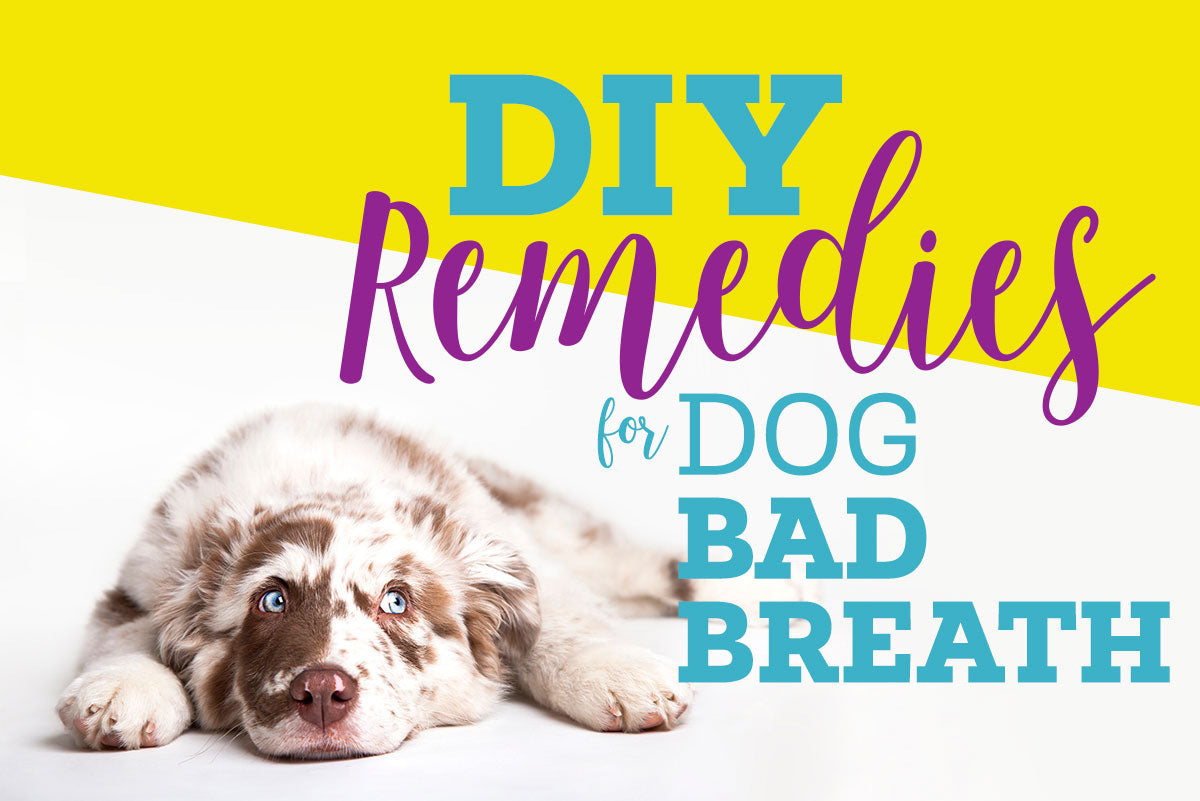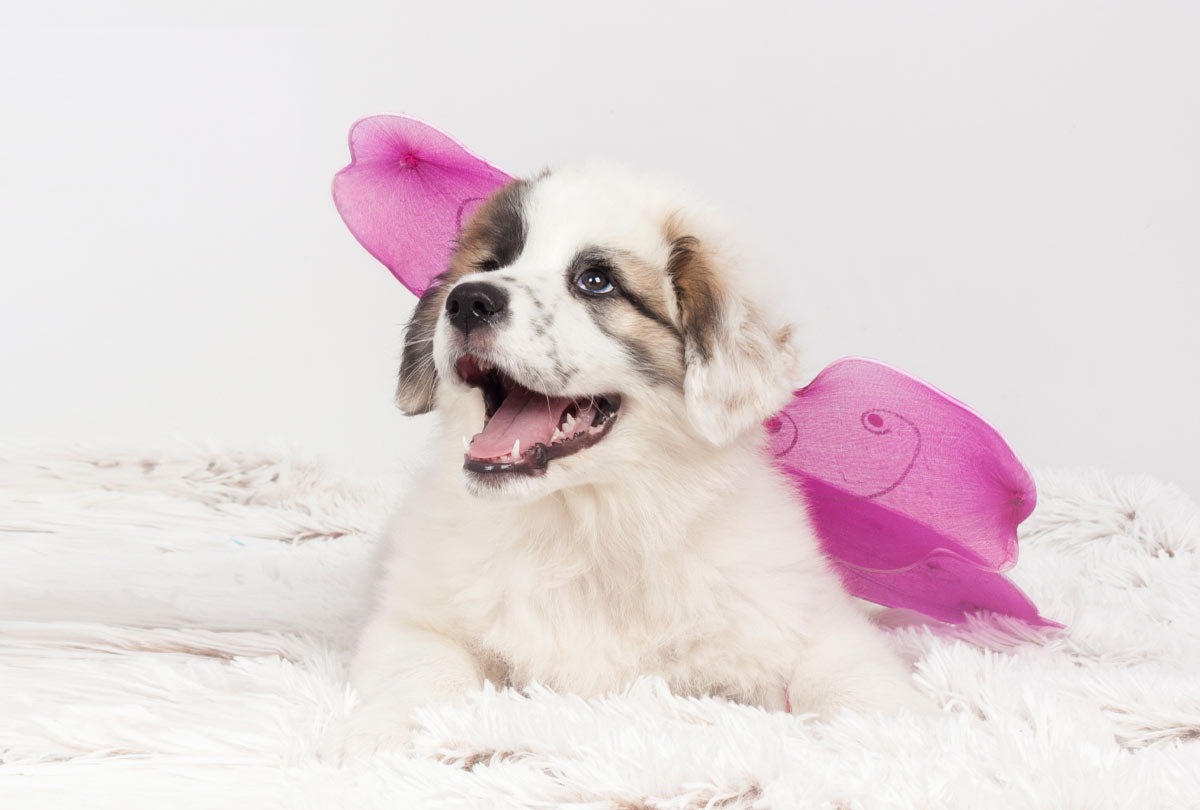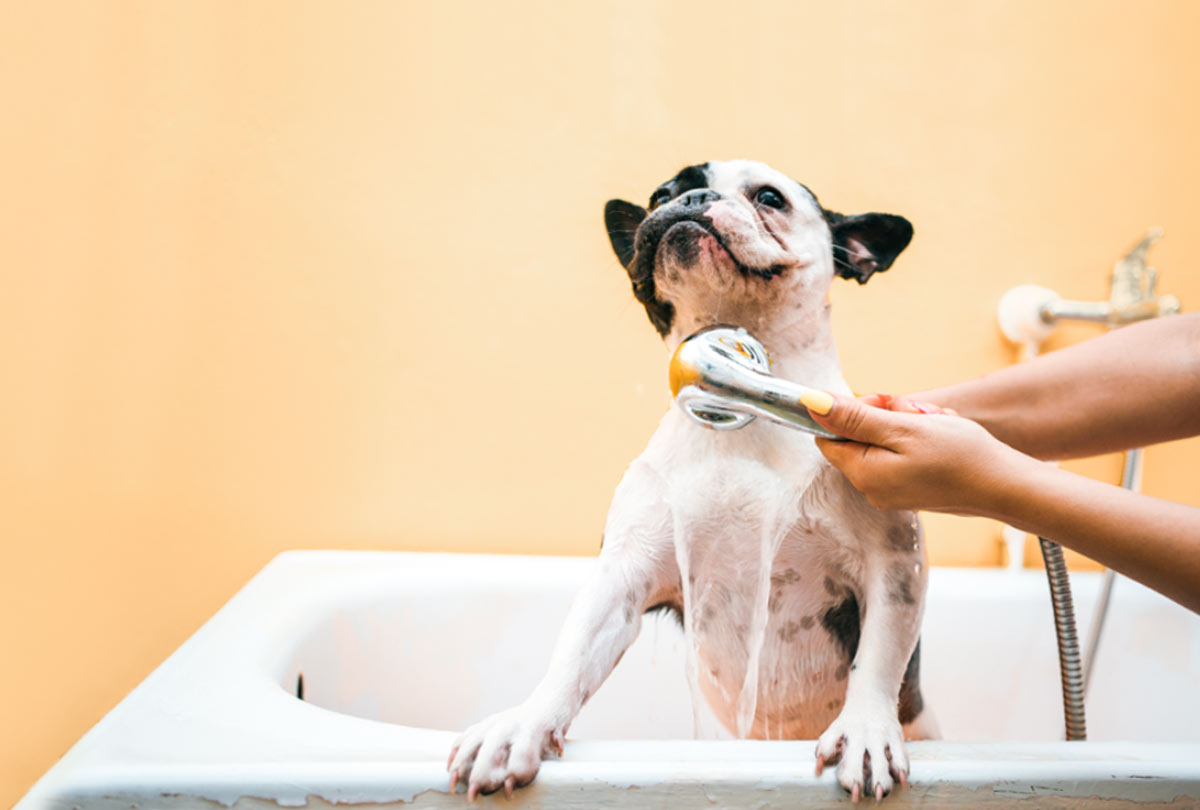Eww, why does my dog have such bad breath?
If this question – along with those loud doggie snores – is keeping you up at night, it’s time to get the answers you need.
While dog bad breath can seem like a losing battle, with some quick action and persistence on your part, it can usually be easily reversed.
For extreme cases of stinky dog breath, a professional teeth cleaning is often needed. If you’re not there yet, however, save yourself some green down the road and follow these simple DIY remedies for dog bad breath.
So What IS Causing That Stinky Dog Breath?
The majority of the time, bacteria from plaque and tartar buildup is the cause of dog bad breath. Not to point paws, or, fingers, but this plaque buildup occurs when owners don’t give their dogs regular dental care at home.
What’s the harm in a bit of plaque?
This clear, sticky film is problematic for dogs’ oral health because it harbors stinky bacteria that multiplies quickly. And it’s not like it can be avoided! Plaque naturally forms on the teeth every time your dog chows down on a meal.
When the gums get inflamed from the bacteria in plaque, this is called gingivitis, the earliest and mildest form of gum disease, or periodontal disease. The good news is, gingivitis is easy to reverse if you give your dog regular oral care.
But if you continue to let plaque run amuck in your pet’s mouth, it will eventually harden into yellow-brown tartar (calculus) that requires professional removal. When tartar gets under the gum line and the dog’s immune system tries to fight the infection, the bones and tissue that hold the teeth in place will begin to deteriorate. Once the destruction reaches a certain point, there’s no turning back. Tooth loss is inevitable and extractions (expensive) may be necessary.
Even worse, bacteria from infected gums can enter into the bloodstream, finding their way to the heart and kidneys, affecting organ function and ultimately, taking years off a dog’s life.
Other causes of bad dog breath include kidney disease, diabetes, tumors or ulcers in the mouth, digestive issues, or a foreign object stuck in the teeth or throat. And, of course, if your dog’s favorite meal seems to be “trash-can surprise” or “poo hash,” this will give your mischievous pup a foul, yet thankfully temporary, bad smell to the breath.
But Isn’t a Dog’s Mouth Actually Pretty Clean?
A common myth is that dogs’ mouths aren’t as dirty as humans. Perhaps this myth started because our canine friends don’t get cavities like we do. But that’s simply due to their narrow and pointy tooth shape and the fact that their saliva is less acidic than humans (pH of 7.5 versus 6.5). That doesn’t mean, however, that they’re immune to harmful bacteria in the mouth that can cause dog bad breath and gum disease. Bacteria that thrive in an alkaline environment are the ones that take up camp inside a dog’s mouth and begin to “reek” havoc.
Are Certain Breeds More Likely to Have Bad Breath?
Small dogs seem to have the biggest problem with bad breath. That’s due to their teeth being closer together, which allows for a greater amount of plaque and tartar to build up. Small breeds that are notorious for having bad breath are Dachshunds, Maltese, Yorkshire Terriers, Chihuahuas and Toy Poodles, to name a few. Additionally, “bearded” dogs like Schnauzers often have bad breath because all that extra hair can trap debris and saliva, allowing bacteria to hang out and cause a stink.
Keep in mind, this doesn’t mean that owners with large dogs are off the hook for taking care of their pets’ smiles. By the age of three, 8 out of 10 dogs have some form of gum disease, and most likely bad breath, as the two go hand-in-hand.
Bad Breath Is a Warning Sign of Pet Gum Disease
Often referred to as “a silent killer,” gum disease is not always obvious at first. While bad breath is normally the first sign of a problem, it sometimes goes ignored because owners unwittingly think that dog breath is a normal phenomenon. In reality, a healthy dog’s mouth really shouldn’t have a smell at all … unless they just ate a meal or got to snack on a coveted piece of salmon skin from your dinner.
Therefore, it’s important to be vigilant and watch for the signs of a problem with your pet’s smile.
Signs of Gum Disease in Dogs
- Red, recessed or bleeding gums
- Visible tartar buildup
- Loss of appetite or difficulty picking up food
- Chewing on one side of the mouth
- Dislikes having face touched
- Loose or missing teeth
- Pawing at the mouth
- Blood on toys, in the saliva or in water bowl
- Dog bad breath
- Sneezing or nasal discharge

6 DIY Solutions to Stop Dog Bad Breath
1. Raid Your Herb Garden
Got an excess of parsley in your garden or some leftovers in the fridge? Chop it up and sprinkle it over your dog’s food for a fast fresh-breath upgrade. This herb is an awesome bad breath fighter because it contains chlorophyll, a natural phytochemical that gives parsley its signature dark-green color. Chlorophyll has antimicrobial properties to fight bacteria and toxins and helps with healthy digestion, giving your dog fresh breath from the inside out.
2. Look No Further Than the Dog’s Water Bowl for Fresh Breath
A refreshingly easy way to support your dog’s oral health is by putting a dental water additive into their water bowl each day. You’ll want to make sure the product you choose is free of alcohol, masking agents (not a true bad breath fixer) and flavorings.
What Vets Recommend: Pet Dental Water Additive is a Family Choice Award winner that’s uniquely formulated with a patented blend of Oxygene® and zinc to stop the plaque attack and neutralize the molecules that cause bad dog breath. Non-toxic, this innovative solution is tasteless and odorless, so your pets will be none-the-wiser about your genius way of improving their gum health and breath.
3. Go Crazy for Coconut Oil
Need yet another reason to go crazy for coconut oil? How about fresh doggy kisses! Just a spoonful of coconut oil over your dog’s food each day will do wonders for that stinky breath. Not only does coconut oil help with dogs’ oral health, it’s also known to increase energy, improve the skin and coat, and help with inflammation. Dogs love the sweet taste, and you’ll love how easy this hack is. Bonus: You can even use coconut oil as a make-your-own doggie toothpaste.
Buyer’s Tip: Select virgin or extra virgin coconut oil, ideally organic and packaged in a glass jar. Steer clear of RBD coconut oil, which is refined, bleached and deodorized.
4. Brush Those Teefers!
Dog tooth brushing is the time-tested method to get rid of bad dog breath and remove plaque. But many owners give this intimidating task the brush-off because they don’t know about the secret ingredient for success: PATIENCE.
That’s right – the biggest mistake pet owners make when jumping into the arena of dog toothbrushing is having too high of expectations initially. The fact is, most dogs aren’t going to be very happy about having their owners suddenly poking around inside their mouths with what resembles a stick, especially if their gums are already sore from gingivitis.
So take it slow and steady – we’re talking only a few seconds – performing short brush sessions until you’re both old pros, ALWAYS praising your dog during and after brushing. Note that in order for toothbrushing to pay off, it should be done a minimum of 3 times a week, and ideally every day for small breed dogs.
There are several options for what you can use to brush your dog’s teeth. This may take some experimenting on your part to see what your pet tolerates the best. Options include a finger brush, doggy toothbrush, a Q-tip or simply clean gauze wrapped around your finger. For the toothpaste, make sure it’s a high-quality toothpaste for dogs – human toothpaste has ingredients like fluoride and sweeteners that can cause some major stomach upset.
Need step-by-step help for brushing your dog’s teeth? Check out: How to Brush Your Dog’s Teeth … Without Losing Your Sanity.
5. Help Your Dog Chew Away Bad Breath
Did you know that dogs that are active chewers have less plaque and tartar build-up? The chewing action helps to scrape away plaque, and even more is removed if the treat or chew has the seal of approval from the Veterinary Oral Health Council (VOHC). Treats and chews with this seal are proven to reduce plaque and tartar by at least 10 percent.
Word to the wise owner: Select those chews and treats carefully! They provide no benefit if your dog can swallow them whole, and instead just pile on the calories. Additionally, some chews, such as rawhides, elk antlers and pig’s ears (recently linked to a salmonella outbreak), can splinter or break off, especially if your dog is a powerful chewer, causing potential choking or blockage issues, as well as digestive upset. (Why trade bad dog breath for bad doggie farts?)
If your dog’s mouth is already in bad shape from gum disease, where the teeth are loose and the gums are inflamed, you’ll want to avoid hard bones and Nylabones, as the chewing action could easily fracture the teeth.
A safe, non-edible chew toy is a KONG®, which you can even fill with a little bit of doggy toothpaste around the rim for some dental care that’s fun too. For chew treats, check out this list of the 6 best chews for dog bad breath.
6. Give Your Pooch a Probiotic for Fresh Breath
For fresh dog breath and a whole lot more – including better digestive health, reduced allergy symptoms and even a happier mood – consider giving your dog a probiotic (live microorganisms.) A dog’s gut houses 70 percent of its immune cells, so no surprise your dog may have more spring to his step while he has more fresh to his breath! Important: a dog’s gut is different than a human’s, so make sure the probiotic is specifically for dogs. Ask your veterinarian for what they recommend for your particular pooch.
Introducing the Easiest At-Home Dental Care Routine for Your Dog
Now it’s easier than ever to adopt a dental care routine for your dog, thanks to the Oxyfresh Pet Dental Kit for dogs. This new travel-size kit costs less than a couple lattes and includes 3 phenomenal dental products for you to try out some of those DIY remedies you just read about:
Oxyfresh Pet Toothpaste (1 oz.): No masking bad breath with mint oils or artificial junk! This vet-recommended dog toothpaste gel with Oxygene® completely neutralizes stinky bacteria on contact, giving your pet fresh breath and healthier gums in an instant. Super versatile, this tasteless and odorless dog dental gel can be applied straight to the gum line to clean, strengthen and deodorize, or use it as a dog toothpaste.
Oxyfresh Pet Water Additive (3 fl. oz.): Alcohol-free, this award-winning pet dental water additive is formulated with a patented combination of Oxygene® and zinc to stop even the toughest dog bad breath. A must for any time your dog needs a blast of fresh breath and gum TLC.
3 Pet Finger Brushes: Many owners find that finger brushes are much more tolerable for their dogs versus a toothbrush. Just slip it on over your finger and apply the Pet Gel Toothpaste to your dog’s gum line to fight harmful bacteria and bad breath. So easy.
Get your paws on this kit and give your dog fresh breath, healthier gums and a new leash on life!
P.S. Got some pet pals looking for relief from stinky dog breath too? Share this article with them.




